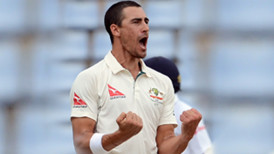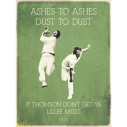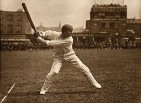You Need Speed (Part Two)
Archie Mac |
1982/83
This was one of the rare series where injuries proved serendipitous. The great Dennis Lillee with 39 and Terry Alderman with 42 wickets respectively, had dominated the bowling in England during the 1981 Ashes, but were both to suffer injuries in the first Test in Perth. Lillee broke down and Alderman provided a demonstration of the wrong way to lay a tackle, dislocating his shoulder after chasing down a pitch invader.
Despite their great form of ‘81, neither Lillee nor Alderman caused the English batsmen too much trouble in that first Test, which petered out to a draw. Their replacements were Jeff Thomson and Rodney Hogg. The former had lost a yard, if not two, of pace and the latter was struggling to cement a permanent place since the return of the Packer stars.
In the end the Aussie pacemen, led by the man who appeared to skate to the wicket, Geoff Lawson, simply out-enthused the England team and claimed back the Ashes lost in 1977. Lawson, Hogg and Thomson proved a surprisingly strong combination although none of them were to dominate an Ashes series again.
1986/87
On paper there wasn’t much to choose between the two attacks. The difference proved to be the discipline shown by the English bowlers. The chest on, “let’s give them some humpty” Graham Dilley was quick and at his peak. His main support was the man with no neck Gladstone Small and Dilley’s partner in the previously mentioned ‘Humpty match” Ian Botham.
When it mattered, England put the ball in the right spots and despite the closeness of the 2-1 victory, were clearly the superior team thanks to their bowlers. The highlight being a three day win at the MCG and that victory was achieved without Dilley.
The Englishmen partied hard after their victory but perhaps they would have partied even harder if they knew this would be their last Ashes win in Australia for almost 25 years. One of the Aussie bowlers who had a decent series, Bruce Reid (20 @26.35), would start the home team’s dominance.
1990/91
The biggest surprise in this series was just how obvious the bowling plans of Australia’s most successful speedman Bruce Reid appeared. Bowling left arm over and generating bounce from a high action, the six foot six Reid simply ran the ball across the batsmen towards the slips. Every now and again he would make one straighten which meant the batsmen had to keep playing at balls outside off stump.
Despite missing a Test, Reid’s simple but effective tactics saw him claim 27 wickets @16. He was well supported by all the other Aussie pacemen: Alderman, Merv Hughes and Craig McDermott. So dominant were the fast bowlers that the only spinner used, Greg Matthews, claimed just 7 wickets @ over 60, as the Aussies won 3-1.
2006/07
The Australian team were christened Dad’s Army before the start of this series. The guard appeared to be changing after England ended the Aussies’ dominant reign of 16 years with a grand victory in 2005. The Aussies were a team of ageing champions but their great bowlers had one more series of dominance left.
Glenn McGrath had never been express but he epitomised the metronome bowler who gave the batsmen nothing and at this stage of his career he seemed to know exactly where every ball would land. Another bowler with a similar work ethic to McGrath, and about the same speed, Stuart Clark was the most successful bowler – 26 @17. This attack had everything including a shock bowler in Brett Lee and, a rarity in Australian conditions, a match winning spinner in the great Shane Warne.
Australia became the first team since Warwick Armstrong’s 1920/21 combination to whitewash a series 5-0. The iconic image was McGrath mockingly grabbing his back like a pensioner as he left the field. Dad’s Army indeed.
2010/11
Another series that was not easy to predict based on the bowling lineups. The home team boasted Ryan Harris, Peter Siddle and left-armer Mitchell Johnson, who had real pace. In the end it was only Harris who lived up to expectations as he topped the Aussie bowling averages. Johnson, apart from one match winning performance, lived up to the Barmy Army ditty “He bowls to the left, he bowls to the right, that Mitchell Johnson, his bowling is shite”.
Conversely England lost one of their best in Stuart Broad after two Tests. Broad’s injury was expected to put pressure on their other ‘A’ grader Jimmy Anderson. The master of swing responded in fine style claiming the most wickets and helped lead England to a 3-1 victory.
Off spinner Graeme Swann may have been the best at the celebratory sprinkler moves but without Jimmy and the other fast men there would have been some severe water restrictions and no English Ashes dance.
2013/14
To be fair we probably haven’t featured a bowler of sheer and destructive pace to follow in the footsteps of Larwood, Tyson and Thomson, since the last named was at his peak during the 1974/75 series.
For Australian fans it was worth the wait as Mitchell Johnson made the Barmy Army’s song redundant. There were balls to the left and balls to the right but they were all bowled so quickly that even the recognised English batsmen couldn’t take full advantage of the occasional loose delivery. As for the lower order batsmen it was a case of six batsmen out all out as Johnson’s pace humbled the tail.
The end result was 5-0 to the Aussies. Johnson completely dominated claiming 37 wickets at a touch under 14. The next best was Ryan Harris with 22 wickets @ 19.31. Once again speed Down Under was the key.
2017/18
So taking the lessons learned since 1920/21, when Armstrong decided to open his attack with two fast bowlers, we can predict who will win the latest Ashes series. The answer, barring injuries, is which team has the better, and fastest, fast bowlers.
After suspensions and unfortunate injuries England have two established Ashes performers in Broad and Anderson. The support bowlers consist of Tom Curran, at 22 years of age he is quick but raw. Another young bowler is Craig Overton who, if he can contain what is rumoured to be a fiery temper, may be a chance of playing in the first Test, given England’s selection woes. One who looks almost certain to play is Chris Woakes, who at 28 should be entering his prime as a fast bowler.
Australia have fewer injury concerns and two express bowlers in left armer Mitchell Starc and right armer Pat Cummins. Both these two bowlers are genuinely quick and in form. Based on what we have learned from Larwood to Johnson, Australia will win 3-1.





Leave a comment